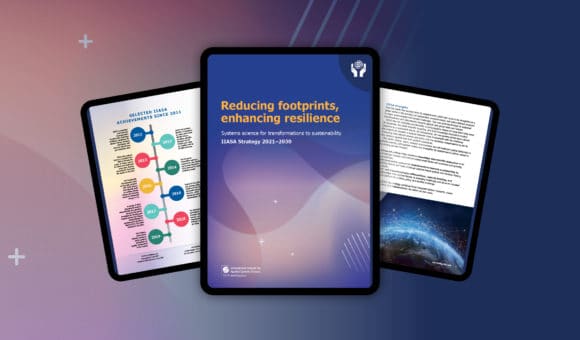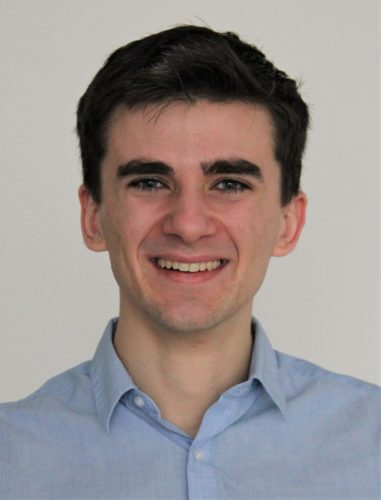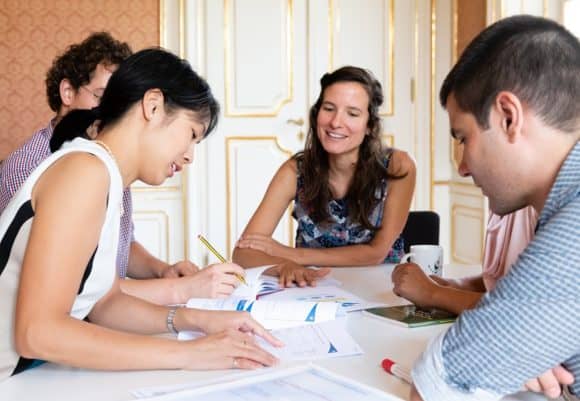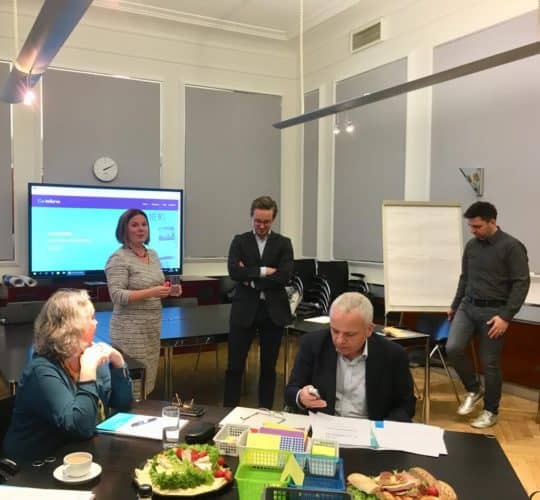Sep 2, 2020 | Communication, Sustainable Development, Systems Analysis
By Rachel Potter, Communications Officer in the IIASA Communications and External Relations Department.
Several members of the IIASA Strategic Taskforce share their views on the bold new IIASA strategic agenda, how it came to be, and what it promises for the future.
What will the world look like in 2030 and beyond? We are living in extraordinary times and our rapidly transforming planet faces multiple global sustainability challenges, threats, and opportunities. How will research institutes like IIASA continue to make meaningful contributions to address these complex issues?

This is precisely what IIASA has been exploring over the past 18 months while formulating its strategic direction for the next 10 years. Through institute-wide consultations, a strategic taskforce was entrusted with coordinating the process that led to “Reducing footprints, enhancing resilience” – the institute’s ambitious new strategy for 2021-2030 that positions IIASA as the primary destination for integrated systems solutions and policy insights.
A bottom-up inclusive approach
The strategy consultation process was very different to those previously undertaken at IIASA. Acting Transitions to New Technologies Program Director and Energy Program researcher, Shonali Pachauri describes the rationale behind the process:
“While in the past strategic planning had largely been driven by the directorate and program directors, this time, mid-career scientists were to drive the process forward. It was not meant to be one researcher from each program on the taskforce, but it ended up being something like that, so we had a broad representation of disciplines from across the institute. The taskforce was responsible for developing the scientific content of the plan and we did this in an inclusive manner with input from staff through workshops, an online platform, and both informal and formal meetings.”
Reflecting our changing world
The UN Sustainable Development Goals (SDGs) established in 2015, are clearly reflected in the new strategy. Linda See, a researcher in the Ecosystems Services and Management Program, explains:
“We have always worked on sustainable development and transformations but this is now more of a focus compared to the previous strategy. The emphasis is on using our expertise as systems scientists to explore the interrelationships between different SDGs and how there can be synergies and trade-offs in different scenarios to achieve them.”
“Another key shift is that the new strategic plan takes a human-centered approach, placing more emphasis on how people are a core component of pathways towards sustainability and resilient societies,” adds World Population Program Deputy Program Director, Raya Muttarak.
Fellow taskforce member and Acting Water Program Director, Yoshihide Wada, agrees:
“This focus on social science, governance, and human behavior came out of our consultations with staff. IIASA researchers really want to go in this direction. People increasingly understand that with the climate and environmental goals in particular, it can’t only be technology and bioeconomy, it has to be about lifestyles as well, which means we need to strengthen our ability to analyze behavior and identify which levers to pull to encourage lifestyle changes.”
“There is also a stronger focus on biodiversity. The importance of this was borne out of the current COVID-19 crisis. Looking at the origin of the virus and how the pandemic has been aided by the loss of biodiversity – it’s evident that this is crucial,” adds Manager of Library and Knowledge Resources, Michaela Rossini.
Building on strong foundations for continued innovation
Taskforce members agree that the new strategy consolidates the unique strengths of IIASA while providing the space and flexibility for innovation.
“IIASA is unique not only because of our excellence in the fields of energy, environment, climate change, and ecosystems services but also because we have strong, empirically-based analyses and studies from social sciences, which can quantify and forecast relevant demographic, social, and economic dimensions in systems analysis,” says Muttarak.
“I think the new strategy pushes the interdisciplinarity at IIASA even further. The new program structure is very integrated. This is vital to facing today’s sustainability challenges. There are big aspirations in the strategy and it’s our responsibility to translate this into practice. As scientists, we have to be open to change and include elements that we may never have thought of. It makes things very interesting. It makes innovation happen,” Wada adds.
Pachauri explains that IIASA was created as a science-to-policy interface in 1972 and its purpose has always been to bridge divides: both between disciplines and across transnational boundaries. The new strategy really builds on this history. While the institute innovates a lot in terms of models and methods, this always happens through an applied lens of doing something that will ultimately feed into policy.
One of the institute’s key strengths is its relationships with its National Member Organizations and strong global network. These relationships are what make it possible to tackle the real-world problems society faces today. The flexibility to work across networks, countries, and different levels of government is strongly emphasized in the strategy.
A bit like family
According to Muttarak, the process of drawing up the new IIASA strategy has been a great opportunity to work with people from different programs and units. Not only has this allowed everyone involved to get to know their colleagues better, but it has also enhanced team members’ understanding of systems analysis and the importance of IIASA.
“It was challenging and rewarding, a bit like family!” comments Pachauri. “There was a lovely dynamism in the team and although we had a Chair, everyone had a chance to lead at various times in the process.”
“As the only non-scientist I found working on the taskforce invaluable – understanding more about IIASA research and getting to know scientists from across the institute has really enhanced my awareness of what they do and what their needs are going forward,” Rossini concludes.
The full IIASA Strategic Taskforce is comprised of: Luis Gomez Echeverri, Matthias Jonas, Mauricio A. Lopes, Junko Mochizuki, Raya Muttarak, Shonali Pachauri, Michaela Rossini, Linda See, Thomas Schinko, Yoshihide Wada, and Fabian Wagner.
Note: This article gives the views of the author, and not the position of the Nexus blog, nor of the International Institute for Applied Systems Analysis.
May 26, 2020 | Energy & Climate
Jarmo Kikstra, a research assistant in the IIASA Energy Program, shares his experience at EGU2020: Sharing Geosciences Online.

© Freepik
When our abstract for the 2020 General Assembly of the European Geosciences Union (EGU2020) was accepted, I was very excited as this would be my first scientific conference. EGU2020 was a few weeks ago and took place completely virtually for the first time due to COVID-19. Let’s reflect upon what this experience was like.
As an early career researcher, I was very much looking forward to presenting the research I have worked on for many months. While I had presented preliminary results of this and other research before, both at my university and at my research department, these presentations had been internal or small-scale. EGU2020 was the first time presenting my research to the public, with experts from various fields being able to see the work and provide their input. It felt to me, like a first step into entering the pubic academic debate, an important step into becoming part of a research community.
But clearly, with the ongoing COVID pandemic, the conference was quite different to what I had expected my first conference to be like. EGU2020 became “EGU2020: Sharing Geoscience Online”. With 16,273 scientists participating last year, clearly a big effort took place to move such an event online, and with 26,219 individual online registrations in the online chat system, it seems to have been a success. But of course, not all registrations are equal, and participation numbers are not the only thing that count. So, how was this virtual EGU2020 experience for me?

© Jarmo Kikstra
First, my experience was much shorter than originally envisaged. While this is largely a matter of choice, I, and many other participants, participated in fewer sessions than we would have done during a physical conference. The simple fact of not being ‘out of office’ contributed to me continuing to work on other ongoing tasks for large parts of the week.
However, the chat session and oral presentation session I joined, were surprisingly intense. Many presentations (that would have normally been poster presentations) were discussed in a plenary chat or oral session, and there was little time (~6 min) available for each presentation, meaning that content was very dense, and discussed at breakneck speed. In this way, a snapshot of the current state of research in my field was provided openly with everyone seeing all comments and all presentations in the session. Something that was missing that could have been useful, by complementing the main chat box, were separate channels for each presentation. This could have made follow-up discussions in the chat sessions easier, without interrupting main discussions on the current presentations, and therewith stimulating one of the most important parts of conferences – feedback on the work you have presented.
Proponents of virtual events will argue that doing this will greatly reduce the environmental footprint of science, as (air) travel is the biggest chunk of GHG emissions of many scientists. In fact, a central debate at EGU2020 discussed this topic, and the first question of the Cercedilla Manifesto reads: “Is a physical meeting necessary?”. Opponents however point to the current impossibilities of replacing the benefits of meeting in-person, including higher engagement, getting an academic network, unexpected (group) discussions, social encounters and events, and the possibility for live feedback, etc. Especially for early career scientists, it is often said that attending conferences is very beneficial.
Networking virtually will never be exactly the same as in person, and I don’t think this is something to aim for. Networking can happen in many different formats; however, it is clear to me now that we can still take quite a few steps into increasing the effectiveness of virtual networking during such events. For instance, I did not ‘meet’ new people, whereas that would have surely happened during a physical meeting, even if I would not have actively made an effort. So perhaps when organizers are putting together a virtual event, it may pay off to be creative in providing virtual networking opportunities.
Many argue that an online event is also much more conducive to opening up science, with an enormous potential for increasing the accessibility to science and scientific discussions and stimulating the development of knowledge. The great success of EGU2020 is probably already in its name: “Sharing Geoscience Online”. On the EGU2020 website you can find thousands of presentations, on all topics that are related to geosciences, with many contributions from IIASA. In other words, a lot of research content has been uploaded to one place, open to everyone; thereby turning this scientific event into a great resource for sharing, learning, asking questions and providing feedback. Discussions on this platform will be ongoing until the end of the month. So, take advantage of this opportunity and have a look!
Note: This article gives the views of the author, and not the position of the Nexus blog, nor of the International Institute for Applied Systems Analysis.
Dec 10, 2019 | Alumni, IIASA Network, Women in Science
By Luiza Toledo, Science Communication Fellow 2019
Luiza Toledo writes about how the IIASA Women in Science Club are creating a safe space to talk about and advance gender equality in science.
Sustainable Development Goal (SDG) 5 is to achieve gender equality and empower all women and girls. A recent report titled, Harnessing the power of data for gender equality produced by Equal Measures 2030, however, shows that we still have a long way to go before this goal becomes a reality.
Countries in Europe and North America, along with two in the Asia-Pacific region (Australia and New Zealand), achieved the highest scores in terms of gender equality on the 2019 SDG Gender Index. However, even in the 20 top scoring countries, there are still indicators that score low. This suggests that even the countries with high overall scores for gender equality are struggling with thorny issues – one of them being women in science and technology research positions.
As an international institute, IIASA was founded on the principles of equal opportunity, which naturally includes equality in terms of gender balance. The institute’s 2018 Annual Report shows that the number of early-career female IIASA scientists has steadily been growing over the last few years. Since 2016, the number of female researchers increased by 24%, with most of the new hires joining as research assistants. Despite this increasing trend, the gap for PhD level researchers is as high as it has ever been with men outnumbering women four to one. In addition, there is a lack of female scientists in the over-40 age group, which is by no means unique to IIASA. Researchers who study gender and science have even compared women’s careers in science with a leaky pipeline – a flawed channel system that loses quantity before it reaches the destination.

©Liebentritt_Christoph
Even though it is unrealistic to expect a 100% retention of women in science related careers (or any career for that matter), male researchers still have a much higher retention rate in scientific careers than their female colleagues do, and this is where the problem lies. According to the IIASA Diversity and Work Environment Report from 2015, male researchers at IIASA on average stay with the institute for seven years, whereas female researchers stay for only four years. To overcome the leaky pipeline effect, we should start creating a workplace culture that aims to recruit and retain women and is more open to discussing and tackling gender issues in academia, thereby developing a safe networking space.
The Women in Science Club (WISC) at IIASA is a great example of a safe networking space that embraces gender equality and shows the power of women that support other women. Co-led led by Amanda Palazzo, a researcher in the institute’s Ecosystems Services and Management Program, and IIASA Network and Alumni Officer Monika Bauer, the club has a self-proclaimed mission to build a network where women connected to science can share experiences, empower themselves, and highlight the work of other women connected to science.
The idea of creating a network of women in science came about in the fall of 2016 when former Finnish President, Tarja Halonen, visited IIASA. During her visit, she asked to meet with the women of IIASA to talk about diversity and equity issues. This conversation was the first of several meetings that are now attended by women (and men) across the institute under the auspices of WISC.
“The conversation was inspiring and after that first meeting, a few of us thought about organizing a club to continue working on the issues that came up from our discussion with President Halonen,” explains Palazzo.
Nowadays, the WISC organizers arrange lunchtime meetings known as “Meet, greet, and eat” sessions to coincide with visits to IIASA by prominent researchers and other professionals from IIASA and elsewhere who want to share their experiences.
“I’ve found that more experienced and senior women who may have been the only women in their departments at the start of their careers or may have had to fight for a seat at the table are often the quickest to agree to meet with WISC. This shows me that they see the value in a club like ours,” Palazzo adds.
Although the number of women now engaged in science is the highest it has ever been, there are still too few women in positions of leadership. According to Palazzo, at IIASA, this situation is set to change with the institute’s newly appointed Deputy Director General for Science who joined IIASA in November this year.
“I’m excited that Leena Srivastava has joined us and I hope that this is just the start of many changes at IIASA that will bring more women into positions of leadership,” she says.
Palazzo says that the most valuable thing that she has learned so far is that no two women have the same story or path to success.
“I found it reassuring to hear successful women tell us that when they were starting out or even several years into their careers they also didn’t know exactly what contribution they wanted to make. They were learning as they went along. It has also been useful to hear women talk about building resilience to negative comments or behaviors and recognize that these behaviors reflect the other person’s fear and insecurity. In the end, the Women in Science Club is a place to share, contribute, listen, and learn. We want women connected to science to feel that they are a member of our community, that they have a seat at our table, and that they belong here,” she concludes.
Note: This article gives the views of the author, and not the position of the Nexus blog, nor of the International Institute for Applied Systems Analysis.
Nov 12, 2019 | Austria, Communication, Demography, Women in Science
By Nadejda Komendantova, researcher in the IIASA Advanced Systems Analysis Program
Nadejda Komendantova discusses how misinformation propagated by different communication mediums influence attitudes towards migrants in Austria and how the EU Horizon 2020 Co-Inform project is fostering critical thinking skills for a better-informed society.

© Skypixel | Dreamstime.com
Austria has been a country of immigration for decades, with the annual balance of immigration and emigration regularly showing a positive net migration rate. A significant share of the Austrian population are migrants (16%) or people with an immigrant background (23%). The migration crisis of 2015 saw Austria as the fourth largest receiver of asylum seekers in the EU, while in previous years, asylum seekers accounted for 19% of all migrants. Vienna has the highest share of migrants of all regions and cities in Austria, and over 96% of Viennese have contact with migrants in everyday life.
Scientific research shows that it is however not primarily these everyday situations that are influencing attitudes towards migrants, but rather the opinions and perceptions about them that have developed over the years. Perceptions towards migration are frequently based on a subjectively perceived collision of interests, and are socially constructed and influenced by factors such as socialization, awareness, and experience. Perceptions also define what is seen as improper behavior and are influenced by preconceived impressions of migrants. These preconceptions can be a result of information flow or of personal experience. If not addressed, these preconditions can form prejudices in the absence of further information.
The media plays an essential role in the formulation of these opinions and further research is necessary to evaluate the impact of emerging media such as social media and the internet, and their consequent impact on conflicting situations in the limited profit housing sector. Multifamily housing in particular, is getting more and more heterogeneous and the impacts of social media on perceptions of migrants are therefore strongest in this sector, where people with different backgrounds, values, needs, origins and traditions are living together and interacting on a daily basis. Perceptions of foreign characteristics are also frequently determined by general sentiments in the media, where misinformation plays a role. Misinformation has been around for a long time, but nowadays new technologies and social media facilitate its spread, thus increasing the potential for social conflicts.
Early in 2019, the International Institute for Applied Systems Analysis (IIASA) organized a workshop at the premises of the Ministry of Economy and Digitalization of the Austrian Republic as part of the EU Horizon 2020 *Co-Inform project. The focus of the event was to discuss the impact of misinformation on perceptions of migrants in the Austrian multifamily limited profit housing sector.

Nadejda Komendantova addressing stakeholders at the workshop.
We selected this topic for three reasons: First, this sector is a key pillar of the Austrian policy on socioeconomic development and political stability; and secondly, the sector constitutes 24% of the total housing stock and more than 30% of total new construction. In the third place, the sector caters for a high share of migrants. For example, in 2015 the leading Austrian limited profit housing company, Sozialbau, reported that the share of their residents with a migration background (foreign nationals or Austrian citizens born abroad) had reached 38%.
Several stakeholders, including housing sector policymakers, journalists, fact checkers, and citizens participated in the workshop. Among them were representatives from the Austrian Chamber of Labor, Austrian Limited Profit Housing (ALPH) companies “Neues Leben”, “Siedlungsgenossenschaft Neunkirchen”, “Heim”, “Wohnbauvereinigung für Privatangestellte”, the housing service of the municipality of Vienna, as well as the Austrian Association of Cities and Towns.
The workshop employed innovative methods to engage stakeholders in dialogue, including games based on word associations, participatory landscape mapping, as well as wish-lists for policymakers and interactive, online “fake news” games. In addition, the sessions included co-creation activities and the collection of stakeholders’ perceptions about misinformation, everyday practices to deal with misinformation, co-creation activities around challenges connected with misinformation, discussions about the needs to deal with misinformation, and possible solutions.
During discussions with workshop participants, we identified three major challenges connected with the spread of misinformation. These are the time and speed of reaction required; the type of misinformation and whether it affects someone personally or professionally; excitement about the news in terms of the low level of people’s willingness to read, as well as the difficulties around correcting information once it has been published. Many participants believed that they could control the spread of misinformation, especially if it concerns their professional area and spreads within their networking circles or among employees of their own organizations. Several participants suggested making use of statistical or other corrective measures such as artificial intelligence tools or fact checking software.
The major challenge is however to recognize misinformation and its source as quickly as possible. This requirement was perceived by many as a barrier to corrective measures, as participants mentioned that someone often has to be an expert to correct misinformation in many areas. Another challenge is that the more exciting the misinformation issue is, the faster it spreads. Making corrections might also be difficult as people might prefer emotional reach information to fact reach information, or pictures instead of text.
The expectations of policymakers, journalists, fact checkers, and citizens regarding the tools needed to deal with misinformation were different. The expectations of the policymakers were mainly connected with the creation of a reliable, trusted environment through the development and enforcement of regulations, stimulating a culture of critical thinking, and strengthening the capacities of statistical offices, in addition to making relevant statistical information available and understandable to everybody. Journalists and fact checkers’ expectations on the other hand, were mainly concerned with the development and availability of tools for the verification of information. The expectations of citizens were mainly connected with the role of decision makers, who they felt should provide them with credible sources of information on official websites and organize information campaigns among inhabitants about the challenges of misinformation and how to deal with it.
*Co-Inform is an EU Horizon 2020 project that aims to create tools for better-informed societies. The stakeholders will be co-creating these tools by participating in a series of workshops in Greece, Austria, and Sweden over the course of the next two years.
Adapted from a blog post originally published on the Co-Inform website.
Note: This article gives the views of the author, and not the position of the Nexus blog, nor of the International Institute for Applied Systems Analysis.
Oct 15, 2019 | IIASA Network, Science and Policy, South Africa
Bettina Greenwell, communications officer at IIASA, talks to Dorsamy (Gansen) Pillay, Deputy CEO: Research and Innovation Support and Advancement (RISA), National Research Foundation (NRF), and IIASA council member for South Africa, about the NRF’s statement on ethical research and scholarly publishing practices. The statement was jointly issued in August 2019 with South African partners within the National System of Innovation (NSI) in South Africa.

Dorsamy (Gansen) Pillay, Deputy CEO: Research and Innovation Support and Advancement (RISA), National Research Foundation (NRF), and IIASA council member for South Africa
What is ethics in research and why is it so important?
Research is a quest for truth. The research must be well conceptualized with a clear research question(s) which can lead to new knowledge. Good ethics and integrity dictate that the truth must be presented in its absolute form, and the findings need to be appropriately interpreted and should be reproducible.
South Africa was awarded the right to host the 7th World Conference on Research Integrity (WCRI) in 2021 in Cape Town – the first time it will be hosted on an African continent. Why is this statement important for the science community in South Africa?
Firstly, it is a privilege to host this conference and South Africa feels very honored. The statement on ethical research and scholarly publishing practices is an important contribution to this conference. We have noticed that South African academics and researchers, especially new and emerging researchers, are under a lot of pressure to publish their work for a variety of reasons. In some instances, ethical principles have been violated. This included the dissemination of research through predatory journals. However, this was not unique to South Africa only as other countries also faced similar challenges. The NRF as a science granting foundation felt compelled to respond to this challenge. The NRF sees itself as a custodian and guardian of research ethics and integrity. Through our peer-review processes, we ensure that research proposals for funding have been robustly interrogated, and the highest ethical principles upheld. As a consequence the NRF developed and issued a joint statement on ethical research and scholarly publications in collaboration with the Department of Science and Innovation (DSI), the Department of Higher Education and Training (DHET), the Council on Higher Education (CHE), the Academy of science of South Africa (ASSAf), Universities South African (USAf) and the NRF. In addition, the NRF has previously issued a statement on predatory publishing.
What do you think will be the key scientific challenges to face South Africa in the next few years? And how do you envision IIASA helping South Africa to tackle these?
There are several challenges, and some of the most pressing ones are poverty and inequality, population migration and unemployment. Given the systems analysis approach, we feel we can draw on IIASA’s expertise to address these challenges. IIASA has used South Africa as a laboratory for its population studies research over several years. It is now time to ensure that this research is translated into policies so that it may impact positively on society.
Housing is also a problem in South Africa. There is a lack of decent, affordable housing for people. The new IIASA strategic plan focuses on smart cities – this could play a role in addressing these housing challenges.
IIASA’s expertise is a systems analysis approach which can be applied to complex issues. The important part of the work is when scientific results are turned into policy – that’s when there is an actual, tangible societal benefit.
South Africa has been an IIASA member since 2007. What have been the highlights of the South Africa-IIASA membership until now?
We see the South Africa IIASA membership as a partnership, and many benefits have accrued through this partnership over the past decade. An example is the Southern African Young Scientists Summer Program (SA-YSSP), which was inspired by the success of the IIASA YSSP. This program ran from 2012 to 2015, and trained the next generation of young scientists.
Another example is the Southern African Systems Analysis Centre (SASAC) initiative, which focused on expanding systems analysis expertise in Southern Africa. Both initiatives were endorsed by the South African Department of Science and Innovation.
About NRF and Dorsamy (Gansen) Pillay
As an entity of the Department of Science and Technology (DST), the NRF promotes and supports research through funding, human resource development and the provision of National Research Facilities in all fields of natural and social sciences, humanities and technology. Dr Dorsamy (Gansen) Pillay is currently the Deputy Chief Executive Officer (DCEO): Research and Innovation Support and Advancement (RISA) of the National Research Foundation (NRF) of South Africa. His thirty-year career in research, teaching, management and leadership includes academic, management and leadership positions at the former University of Durban-Westville and at the Durban University of Technology. His research has focused on both prokaryotic and eukaryotic microorganisms, from human diseases to bacterial plant diseases with particular emphasis on elucidating the molecular architecture of the causal microorganisms with a view to understanding genetic diversity, extra-chromosomal elements and developing rapid disease diagnoses. He is currently Vice Chair of the IIASA Council.
Notes:
Please click on the link to read the statement on ethical research and scholarly publishing.
More information on IIASA and South Africa.
This article gives the views of the authors, and not the position of the Nexus blog, nor of the International Institute for Applied Systems Analysis.








You must be logged in to post a comment.